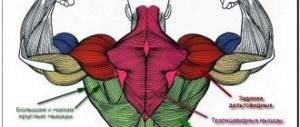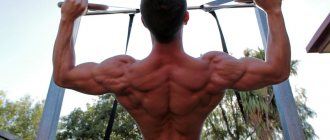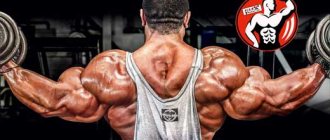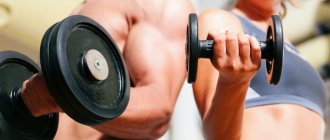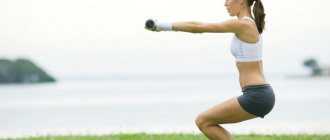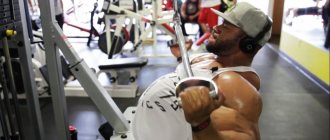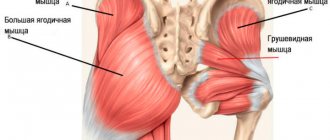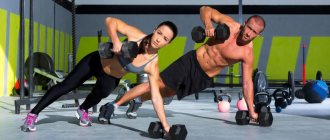Back training is necessary for three reasons: ensuring correct posture, which maintains the health of the spine and internal organs, the important role of these muscle groups in various power movements, and a stately appearance of the figure.
At home, having an entire arsenal of effective means for maximum muscle development and pumping is very problematic. All these products take up a lot of space at home and are very expensive. And back exercises in the gym can provide the most versatile and diverse workout of the muscles of the back of the torso, as well as weight loss.
The gym is also more advantageous than home classes in the psychological aspect, which helps fight laziness - visiting the “gym” obliges you to give your best, so as not to lose face in front of other visitors and not miss classes when money has already been paid for them.
Content
- 1 Back workout in the gym
- 2 Introduction to the muscles of the upper back
- 3 Development of the muscles of the upper back
- 4 How to avoid mistakes when training your upper back muscles
- 5 Best Upper Back Exercises 5.1 One-Arm Dumbbell Rows
- 5.2 “Pullover” with dumbbells
- 5.3 Shrug with dumbbells
- 5.4 Machine deadlifts
- 5.5 Row on a high block
- 5.6 Traction on a low block
- 5.7 Pull-ups on a machine
- 10.1 Pelvic descent
Exercises for the trapezius muscle of the back[edit | edit code]
The trapezius muscles begin at the base of the skull, radiate toward the shoulders, and run down between the shoulder blades. These muscles are extremely important for bodybuilders. There is no such thing as a harmonious figure with poorly developed trapezius muscles.
Exercises at home[edit | edit code]
Deadlifts are performed with available weights.
Weight-bearing exercises[edit | edit code]
Basic exercises:
- Chin pull
- Chin pull
- Bent-over dumbbell row
Isolation exercises:
- Shrugs
- Shoulder raise with dumbbells
- Shrugs
- Shrugs
- Shoulder raise with dumbbells
Exercises on simulators[edit | edit code]
Isolation exercises:
- Pulling the block to the side with both hands
- Pulling the block to the side with both hands
Back training in the gym[edit | edit code]
Main article:
Back - exercises and training features
Yuzhakov Anton BEST EXERCISES FOR LATISM MUSCLES
More than eighty percent of adults have experienced back pain at least once in their lives. Such pain is perhaps the main cause of disability. Therefore, you simply need to be proactive and strengthen your back to avoid injury! Staying healthy and strong can greatly improve your quality of life. Having a strong back is important for many daily activities, including recreation, entertainment and work. In addition, sculpted back muscles improve the aesthetics of your figure and appearance.
This article includes two sections dedicated to training the upper and lower back, respectively. Even though these muscle groups are located in close proximity to one another, they do different jobs and require different training. Many upper back exercises involve lifting quite a lot of weight. Exercises for the lower back involve lighter movements, often without any additional weight. You can choose the best exercises for the gym.
Adviсe
Tips for doing back exercises:
- A narrow grip during lat pulldowns and pull-ups somewhat transfers the load from the outer zones of the lats to the biceps and lower part of the lats. By varying different grips, you can achieve a varied load.
- With a narrow grip, during pull-ups and rows of the upper block, more muscle stretching occurs than with a wide grip - when visiting the gym, you can alternate these options each time.
- To hold the weight in the hands, the muscles of the forearms and hands work . If it is weak, then performing back exercises will be problematic. In this case, you can use wrist straps, which any athletic gym has, but it is better to train your grip strength with special exercises.
- As an exception, chest exercises are placed ahead of back exercises if the pectoral muscles are severely lagging behind in development. This technique in bodybuilding is called the principle of priority, but, as a rule, it is advisable mainly for experienced athletes who have been visiting the gym for several months.
- You can jump onto the horizontal bar, but it is not advisable to jump off it due to the sharp shock load on the spine. It is best if the hall is equipped with a crossbar attached to the wall bars, and you can use it to climb on and off the horizontal bar.
- If there is not enough body weight when doing pull-ups, then you can hang weights on your belt for additional load. This is done using an athletic belt, a chain with a carabiner and a barbell plate. All this equipment is contained in any gym. It is advisable to choose a gym with the maximum range of devices, equipment and exercise equipment, which will allow you to work out the body in the most versatile way possible.
- It is better if the gym has several copies of each exercise machine - this way the classes will go faster due to the elimination of waiting in line for the equipment.
- To control your exercise technique, it is useful to use a mirror, which is equipped in any gym.
Alexandrova Anastasia
Nutrition and healthy lifestyle specialist and author of myfitnesblog.com. For many years, she has successfully helped women and men lose weight and maintain a beautiful figure.
Introduction to the muscles of the upper back[edit | edit code]
Back muscles
Pull a chair towards you and sit comfortably. Let's talk about the muscles of the upper back. What can I tell you? You just used them! You use them whenever you pull anything towards you, be it furniture, a stubborn retriever on a leash, or a mountain of chips with which you snack on beer.
Your upper back includes several major muscles.
- Latissimus
dorsi
.
_ These are the largest muscles in the back and run just behind each armpit and reach to the center of the lower back. In common parlance, athletes often call them winglets
. As a rule, these muscles are very well developed in swimmers, especially butterfly swimmers. It is the lats that give swimmers’ torsos a V-shape. Their main task is to pull your arms (and what you are holding in your hands) towards your body.
- Trapezoid
(
Trapezius
). Above the latissimus are two trapezius muscles. They run from the top of the neck to the edge of the shoulders and taper down to the center of the back. These muscles allow you to shrug your shoulders (like when your husband (or wife) asks how you could forget to pay your phone bill). More importantly, the lower trapezius stabilizes the shoulders and helps prevent shoulder injury. The upper ones help you move your head back and to the sides or look around to see what is happening behind you.
- Diamond-shaped
(
Rhomboides
). These muscles are located between the spine and shoulder blades. Along with the trapezius, they are used to bring the shoulder blades together. People who spend long hours at a computer or in other sedentary positions often have overstretched and weak rhomboid muscles.
There are great benefits to strengthening your upper back muscles.
- Real Life Benefits
. Having a strong upper back will make it easier for you to drag your kids to the dentist's office or carry suitcases through endless airport terminals. You can improve your posture, say goodbye to slouching, and quickly get rid of the feeling of tension in your neck and shoulders.
- Preventing Injuries
. Strong upper back muscles play a very important role in keeping your shoulders healthy. The latissimus muscles do most of the work during pulling movements, so strengthening them prevents your shoulders from becoming overextended. Among other things, well-developed upper back muscles can protect you from injury when pulling out the sofa for guests.
- Feeling good
. Exercises to develop your upper back make it wider, which in turn makes your waist look slimmer. These exercises also improve your posture, helping you stand up straight and appear taller. They help you open your chest and stop slouching like before. Thanks to this, you become more confident and begin to feel healthier.
Developing the muscles of the upper back[edit | edit code]
Exercises for developing the muscles of the upper back in the gym are divided into three categories: rows on a high block and pull-ups, rows on a low block, “pulovers” - lowering the straightened arms with a dumbbell back behind the head while lying on a bench. For better development of the upper back muscles, we recommend doing exercises in all three categories, although they do not necessarily need to be included in one workout.
- High block rows and pull-ups.
When performing a high pulldown, you hold on to a metal bar hanging on a cable from a block attached above your head and pull it down. When doing a pull-up, you hold a bar or special handles above your head and pull your body up. When working out at home, you can imitate working on a machine using a rubber band or expander. Pull-ups and pull-ups are combined into the same category because they work the back muscles in the same way. Both exercises target the lats, trapezius, and rhomboids, but also strengthen the biceps, shoulders, and chest.
If you want to get a wider back and improve your posture, then high blocks and pull-ups will be especially useful for you.
- Rows on a low block.
Exercises on low blocks are similar to rowing a boat. They can be performed on machines with levers or handles on cables, with a barbell or dumbbells, as well as with a harness or expander. Low block exercises develop the same muscles as high block exercises or pull-ups, with the exception of the chest muscles. They are especially useful if you want to learn to sit with a straight back.
- "Pullover".
For brevity, this is the name for lowering straightened arms with a dumbbell back behind the head, performed while lying on a bench. When performing a pullover, your arms move up and down in an arc, as if you were raising an ax over your head to chop wood. The pullover develops the latissimus muscles, as well as the muscles of the chest, shoulders and abdomen. Like other exercises for developing the muscles of the upper back, they improve posture. Plus, the pullover is ideal for transitioning from a back workout to a chest workout. In other words, it is good to use it to complete a complex for the back and begin a complex for the chest - after all, a pullover helps the pectoral muscles warm up and prepare for the main loads.
Whether you're doing pull-ups, rows, or pullovers, keep reminding yourself that these exercises should primarily strengthen your back muscles, not your arms. In this case, your hands are simply a connection between the bar and the back muscles, which do the bulk of the work. Focus on starting each exercise from the outside of your back. This advice may be difficult to follow at first, but as you get stronger and more experienced, your body will become better at recognizing these moments. After some time, you will already know exactly where you should feel each exercise.
Most of the upper back exercises in this chapter use weight machines or cables with pulley handles. But what if you're going to work out at home and don't have a multifunctional machine (the home version of club equipment)? In this case, a rubber band or expander will help you.
Bent-over dumbbell row
Performing an exercise for the thickness of the back allows you to thoroughly work out the latissimus muscles, rhomboids, teres major, and deltoid muscles. First, rest your leg bent at the knee and your straight arm on the bench. The straight back is tilted forward, held at an angle of 45° relative to the plane of the floor. Hold the dumbbell with your free outstretched hand. As you inhale, the sports equipment is smoothly pulled towards the chest, bending the limb at the elbow. During the movement, the back muscles are kept in the most tense state. Having reached the chest with a dumbbell, slowly lower the load down while exhaling.
The effectiveness of the exercise to increase your back is determined by the weight of the dumbbell. The heaviest possible projectile should be used. Otherwise, achieving the expected result will be slow. When moving the dumbbell to the lower position, you should pay attention to the qualitative stretching of the muscles in the middle of the back. The work should not be done solely by the biceps and triceps.
How to avoid mistakes when training the muscles of the upper back[edit | edit code]
When training the upper back in the gym, we often see failed heroes. The fact is that when working on the upper or lower block, practitioners often try to use more weight than they can lift, so they begin to involve their whole body in performing the exercise. And this is wrong, because it practically does not develop the upper back muscles, but can easily lead to injury.
Here are some tips for developing your upper back.
- Do not jerk your body backwards, forwards or to the sides.
In an attempt to pull the load towards themselves, many begin to wriggle their whole body in order to create a moment of inertia, but this is precisely not necessary. Instead, you should rely solely on the strength of your back muscles. If you find that your body moves from side to side when you try to raise or lower the weight, remove a couple of heavy plates from the machine.
- Don't lean too far back.
It's possible that by leaning back you'll lift the weight more, but that's at the cost of gaining extra leverage and cheating your body weight into the work, rather than strengthening your back muscles. A straight seat will make your workout as effective as possible. Every time you pull the load towards you, lower your shoulders down, squeeze your shoulder blades together and sit up straight. When working on a high block, you can lean back slightly, but for a low block you should sit with your back as straight as possible. Imagine that you are flying on an airplane and the flight attendant asks you to put the backs of your seats in an upright position, fasten your seat belts and raise the folding tables.
- Do not place the bar behind your head and neck.
Among the endless variations of high pulley exercises, there is only one that many experts today are against: the head pull. Critics claim that it moves the arms too far back, causing the shoulder bones to become pinched in the shoulder joint. In this case, overstrain of the ligaments and stretching of the rotator muscles may occur. Therefore, unless you are seriously into mountain climbing, rowing or butterfly swimming, pulling the bar in front of you will be quite enough.
Indications for physical education
Dosed and well-chosen exercises for the back muscles are indicated in the following cases:
- Posture disorders. It's never too late to learn to walk straight, but before starting classes you need to consult a chiropractor and make sure there are no contraindications.
- Osteochondrosis in all parts of the back. Exercise therapy is the basis of conservative treatment. Thanks to the exercises, the nutrition of the intervertebral discs improves, the nerve roots are decompressed, the muscle corset is strengthened, and blood and lymph circulation increases.
- Myositis. This is a muscle disease accompanied by the appearance of nodules in the tissues. Doctors recommend starting exercises after the inflammation has subsided. Preference should be given to varieties aimed at stretching muscle fibers after thoroughly warming them up.
- Curvature of the spine. Kyphosis, lordosis and scoliosis in the initial stages can be treated very successfully. The use of exercise therapy in these cases is justified only as part of complex therapy (together with traction (extension), massage, physiotherapy) and strictly under the supervision of a doctor.
- Sedentary (especially sedentary) lifestyle. Insufficient physical activity can be compensated by regular training in the gym or at home.
- Strengthening health, improving well-being. A straight, strong and flexible back is the key to health; strengthening it is the prevention of many neurodegenerative diseases.
Before performing a set of exercises for the back, I always do a warm-up, sometimes I do a little cardio training (running, jumping rope, exercise on an orbit track) and after it, I stretch and relax the worked muscles. It has been tested in practice: this is how the maximum benefit from training is achieved.
A healthy back is not only strong, but also flexible
The best exercises for the upper back[edit | edit code]
This section covers exercises for the upper back muscles, typically performed with dumbbells or machines. It will also teach you how to smoothly transition from dumbbells to barbells to power machines. And here is a list of exercises for developing the muscles of the upper back, which are discussed in detail later in this article.
- One-arm dumbbell row.
- Pullover with dumbbells.
- Shrugging shoulders with dumbbells in hands.
- Deadlift on the simulator.
- Pull down on a high block.
- Traction on a low block.
- Pull-ups on the simulator.
One-arm dumbbell row[edit | edit code]
Rice. 2. One-arm dumbbell row. Focus on working your back muscles rather than just moving your arm Main article:
Bent-over one-arm dumbbell row
This exercise focuses primarily on developing your back muscles in the gym, but also strengthens your biceps and shoulders.
Be careful if you have lower back problems.
Preparing for the approach
Stand to the right of a weight bench and hold a dumbbell in your right hand with your palm facing your body. Pull your stomach in and lean forward at the pelvis, arching your back naturally and roughly parallel to the floor. Bend your knees slightly. Place your left hand on the top of the bench in line with your left shoulder, and lower your right hand freely. Tilt your chin slightly towards your chest so that your neck is in line with your spine (Photo A in Fig. 2).
Exercise
Pull your right arm up, keeping your hand in line with your shoulder and lifting the dumbbell parallel to the ceiling. Raise your hand up until your clenched fingers touch your side. Then slowly lower the dumbbell and return to the starting position. Repeat the exercise with the other hand (photo B in Fig. 2).
What to do and what not to do
- Remember that although only the arm moves during the exercise, the exercise develops the back. Concentrate on working the muscles in your back (behind and just below your shoulder) rather than simply moving your arm up and down.
- Keep your stomach pulled in throughout the exercise.
- Do not allow your back to sag towards the floor or your shoulders to rise.
- Do not yank the load sharply upward.
Other options
- Row with rotation.
As you lift the dumbbell, rotate your arm so that your palm is facing outward at the end of the movement. With this technique, the exercise causes a different sensation and puts additional stress on your biceps. - Barbell deadlift
. Place the barbell on the floor and stand about 30cm away from it. Bend your knees, lean forward and grab the bar with an overhand grip, keeping your hands slightly wider than shoulder-width apart. Pull your stomach in and keep your back straight, do not arch. Bend over your pelvis so that your torso is at a 45° angle to the floor. Pull the barbell towards your lower chest and then slowly lower it back down. You can also do this exercise using an underhand or narrower grip, keeping your hands close to each other.
“Pullover” with dumbbells[edit | edit code]
Rice. 3. “Pullover” with dumbbells. Do not arch your back while doing this exercise Main article:
Pullovers
This exercise is aimed mainly at developing the back, but also develops the chest and shoulder muscles, biceps and abdomen.
If you have shoulder or lower back problems, you may want to skip this exercise as it requires raising your arms overhead with your back straight.
Preparing for the approach
Hold one dumbbell with both hands, lie on your back on a bench with your feet flat on the floor, and raise your arms straight above your shoulders. Turn your palms up, holding the dumbbell by the end. Pull your stomach in; the back should be relaxed and arched naturally (photo A in Fig. 3).
Exercise
Keeping your elbows slightly bent, walk the dumbbell back until the bottom end of the dumbbell is behind your head. Then return the dumbbell to the starting position. Do not straighten your elbows during execution (photo B in Fig. 3).
What to do and what not to do
- Make sure that the dumbbell is securely held in your hands.
- Concentrate on engaging your back muscles in the movement, rather than simply bending and straightening your arms.
- Don't arch your back over the bench, especially when lowering the weight.
- Don't place the load too far behind your head.
Other options
- “Pullover” with a barbell
. Try this exercise with a barbell, holding it in the center with an underhand grip. Another way is possible: hold a dumbbell in each hand with your palms facing you. - “Pullover” on the simulator
. Many gyms have machines that simulate doing a “pullover” with a dumbbell in a sitting position. - “Pullover” across the bench
(heavier). Try this exercise by squatting in front of a weight bench with your shoulders resting on it. Because the bench won't support your entire body, you'll have to work extra hard to maintain good posture. This version of the exercise is interesting because it forces the deep muscles of the back and abdomen to work.
Shrug with dumbbells[edit | edit code]
Rice. 4. Dumbbell Shrug. Shrug your shoulders rather than roll them Main article:
Dumbbell shoulder raises
This movement has a very significant benefit: it strengthens the shoulders and trapezius muscles of your upper back.
Be careful if you experience frequent neck pain.
Preparing for the approach
Stand up straight, hold a dumbbell in each hand and lower them in front of your thighs, palms facing you. Tuck your stomach in, tilt your chin slightly toward your chest, and relax your knees (Photo A in Fig. 4).
Exercise
Raise your shoulders up, then slowly lower them (photo B in Fig. 4).
What to do and what not to do
- Keep your neck and shoulders relaxed.
- Avoid rotating your shoulders in a full circle; this is a common mistake that puts unnecessary strain on your shoulder joints.
- Don't move other parts of your body.
Other options
- Barbell Shrug
. Grab the bar from above with your arms shoulder-width apart and stand so that the bar is in front of your hips. The rest of the exercise is performed as usual. - Shrug with rotation
(harder). Shrug your shoulders, lift them up, as in the main version, and then squeeze your shoulder blades together. Then lower your shoulders and return to the starting position. This version of the exercise will help to engage the trapezius and rhomboid muscles of the back. - Modified deadlift
. Stand straight with your feet hip-width apart and grab a barbell in your hands, placing it in front of you at waist level. Spread your hands about 15 cm from one another. Bend your elbows to lift the bar forward just above your navel, then slowly return to the starting position.
We don't recommend performing a full deadlift, which involves raising your arms until the bar is directly under your chin. This exercise can place too much stress on the shoulder and wrist joints, ligaments and tendons.
Deadlift on the simulator[edit | edit code]
Rice.
5. Deadlift on the simulator. Sit up straight when performing machine deadlifts. This exercise is primarily designed to develop your back in the gym, but also strengthens your shoulders and biceps.
Approach this exercise especially carefully if you have had shoulder or lower back injuries.
Preparing for the approach
Sit facing the machine and rest your chest on a special pillow. Adjust the seat so that your arms are level with the handles of the machine and you have to fully extend them to reach the handles. Many people forget how important such adjustment is: if during an exercise you cannot fully straighten your arms, then their muscles will work much more than your back muscles. Firmly grasp the handle with each hand, lower your shoulders down and sit up straight (photo A in Fig. 5).
Exercise
Pull the handles of the machine towards you until your hands are on the sides of your chest. When bending your elbows, point them straight back, but not to the sides. At the same time, squeeze your shoulder blades. Slowly return your arms to the starting position, feeling the tension in your shoulder blades (photo B in Fig. 5).
What to do and what not to do
- When you are about to pull a load towards you, sit up straight.
- Do not lean too far back so that when you bend your arms, your chest does not come off the special pillow.
- Do not hunch or lean forward as you return your arms to the starting position.
- Do not lean your head forward when lifting the load.
Other options
- Other simulators
. Although each manufacturer has their own version of the deadlift machine, they all use the same principle. Depending on the brand, the handles can be positioned horizontally, vertically or diagonally, and some machines allow all three types of grips. Try experimenting with different hand positions to get different feels from the same exercise. - Advanced deadlifts
(heavier). This machine does not have a special chest support pad. Accordingly, without support, you will have to make more efforts to keep your back straight.
Thrust on a high block[edit | edit code]
Rice. 6. Deadlift on a high block. When pulling up the bar, do not lean back more than 2-5 cm Main article:
Vertical pull-down
This exercise is aimed primarily at strengthening the back muscles, although it also strengthens the shoulders and biceps. Try experimenting with different grips and bars.
Be especially careful if you have shoulder or lower back problems.
Preparing for the approach
To begin, sit on the seat and adjust the special thigh pad. It should firmly fix your legs with your knees bent and your feet fully flat on the floor. Then stand up and grab the bar from above, spreading your arms about 15 cm wider than your shoulders. While still holding the bar, sit on the machine seat and slide your feet under the pressure pad (it should be directly above your knees and hips). Straighten your arms up, lift your chest and lean back slightly (photo A in Fig. 6).
Exercise
Smoothly pull the bar up to the top of your chest. Hold this position for a moment, and then slowly raise the bar again. Having completely completed the approach, get up from the machine and carefully return the load to its place. For more details, see photo B in Fig. 6. Do not let go of the bar suddenly while continuing to sit - sudden relief has a bad effect on the muscles, and you don’t need the sound of a falling load at all.
What to do and what not to do
Do not rock back and forth in the seat, trying to pull the load towards you.
- Don't lean too far back. Maintain the same position at all times as at the beginning of the movement.
- Don't work too fast to avoid damaging your elbows and shoulders.
- Don't bend your wrists.
Other options
- Changing grip
.
Experiment with the width of your grip and the direction of your palms to get a different feel from this exercise. For example, try using a triangle handle for the triangle grip row
.
Or use an underhand grip ( reverse grip row
) and keep the bar close to the center, performing an exercise that feels like a chin-up. Just don’t put the bar behind your head (for reasons, see “How to Avoid Mistakes When Working Your Upper Back Muscles” earlier in this chapter). Also experiment with other handles or bars, varying their length and shape.
Low block traction[edit | edit code]
Fig.7. Traction on a low block. When working, you should feel tension in your back, and not just in your arms Main article:
Horizontal block row
This exercise strengthens your back as well as your biceps and shoulders.
Be careful if you have lower back or shoulder problems.
Preparing for the approach
Attach a short and straight bar to the cable. Place a step platform or box of suitable length at the base of the machine. (Some machines have special seats and supports, so they don't require a box.) Sit on the floor, facing the machine, with your legs slightly bent, hip-width apart, and firmly resting on the box. Grasp the bar and straighten your arms in front of your chest. Try to sit as straight as possible, with your shoulders down, your stomach in, and your chest up (Photo A in Fig. 7).
Exercise
While sitting upright, bring your arms toward your lower chest, squeezing your shoulder blades together. The elbows should be directed straight back, and the hands should lightly touch the sides at the end of the movement. Without leaning forward, slowly straighten your arms, returning to the starting position (photo B in Fig. 7).
What to do and what not to do
- Feel the tension in your back, not just your arms. Concentrate on starting the movement from the outer edges of your back.
- Don't arch your back forward or backward.
- Don't rock back and forth to make it easier for yourself.
Other options
- Extended rod
. The basic version of this exercise is great for working the upper back muscles, but you can also strengthen your lower back by bending slightly forward as you straighten your arms and leaning back as you reverse the movement. Some exercise purists protest this option because it does not “isolate” the upper back. However, the long row develops all the muscles in the back and is great for people who are active in rowing, dancing, mountain climbing, or weeding. It will not suit you only if you suffer from lower back pain. - One-arm low block row
. Attach a special horseshoe-shaped handle to the cable and do the exercise with each hand in turn.
Pull-ups on a machine[edit | edit code]
Rice. 8. Pull-ups on the simulator. Do not swing your body from side to side Main article:
Pull-ups on a machine
This exercise is primarily aimed at developing your back muscles in the gym, but also helps strengthen your shoulders and biceps.
Be careful if you have lower back or shoulder problems.
Preparing for the approach
Stand on the platform of a pull-up machine (sometimes called a gravitron) and carefully lower your knees onto the pads. (Some models require you to stand up straight.) Grasp the handles of the machine with an overhand grip and straighten your arms. Pull your stomach in and straighten your body (photo A in Fig. 8).
Exercise
Pull yourself up until your elbows are pointing straight down, and then slowly lower your body to the starting position (Photo B in Fig. 8).
What to do and what not to do
- Relax your shoulders so they don't rise
- Don't rock your body, making it easier for you to move up and down.
- Don't arch your back.
- Don't make long stops at the bottom. Work evenly until the end of the set.
Other options
- Different grips.
Some pull-up machines offer wider or narrower handles. Experiment with the placement of your brushes to find what works best for you. - Pull-ups on the bar
(heavier). Using a Smith machine or power cage, securely attach the bar to the clamps in the center of the frame. Grasp the center of the bar from below with your hands, the distance between your hands is approximately 5 cm. Place your legs in front of you so that the body is tilted 45° to the floor surface. Bend your arms and pull yourself up until the top of your chest comes close to or touches the bar. Then slowly and carefully lower yourself to the starting position.
Benefits of strong lower back muscles[edit | edit code]
Most lower back exercises—especially those designed for beginners—do not involve free weights or machines. As a rule, just you is enough for them. However, you can achieve a lot with absolutely no additional equipment.
- Real life benefits.
Sitting puts significant pressure on your spine—much more than standing all day, with most of the stress on your lower spine. That's why you often feel discomfort in your lower back after sitting at the computer until late in the evening. Moreover, weak lower back muscles cause you to hunch or arch your lower back, putting even more pressure on your spine.
If you have a sedentary job, try to strengthen and stretch your lower back muscles regularly. It is advisable to get out of your chair every hour for at least a couple of minutes to stretch.
- Preventing injuries.
It's sad that even people with chronic lower back pain neglect exercises to strengthen their muscles for fear of harming themselves. However, if you have lower back problems, this is perhaps the most compelling reason to start regularly strengthening your back muscles.
- Feel good factor.
Strengthening your lower back muscles helps you stand up straight, which in turn makes you look taller and three pounds slimmer. A straight back gives you a confident and business-like appearance.
Developing the muscles of the lower back.[edit | edit code]
We all think that our muscles simply have to serve us well. But in fact, in order for them to help us, we must help them by developing their strength and flexibility.
Not only strength is important, but also flexibility. That's why we included pelvic lowering in the list of exercises, which not only strengthens, but also stretches the muscles attached to the spine. Given a sedentary lifestyle, this exercise will be useful for everyone. The same can be said for stretching your back.
However, if you have severe or chronic back pain, do not rush to start exercising—consult your doctor first.
When performing exercises to develop your lower back, you should feel a slight tension or pressure in the muscles, but not severe pain. If severe pain occurs, exercise should be stopped immediately. Check if you are doing everything correctly and try again. Seek advice from a trainer. If you are doing everything correctly, but the pain does not go away, visit a doctor.
You may feel a dull, aching pain in your back for a day or two after you start exercising—this is normal. But if the pain is sharp and very strong, it means that you either over-exercised, or you have serious back problems that need to be treated.
Pumping tips from the pros
Training the back muscles requires a special approach. Professionals recommend taking into account the characteristics of the body, primarily the spine, since it is significantly susceptible to injury and damage.
Classes should also be structured taking into account the athlete’s goals. Working on strength, mass, weight loss and relief requires a different approach, and accordingly, different exercises and principles will be selected.
Stanislav Lindover, bodybuilder
A well-known bodybuilder and trainer recommends starting back training with basic exercises, if there are no contraindications. If there are problems with the spine, it is best to perform simpler movements and pay special attention to hyperextensions and gymnastics to strengthen the muscle corset.
Tedy Bass, trainer
Trainer Tedy Bass, who has trained more than one Hollywood actor, believes that classes should be structured depending on the athlete’s goals. You cannot choose a general program and use it in all situations. It is important to take into account the characteristics of the body and its actual capabilities, and increase the load gradually.
Ekaterina Krasivina, fitness bikini
The famous Russian athlete, who performs in a fitness bikini, advises not to ignore back training, even for girls who often work on other muscle groups. The program should distribute the load evenly throughout the body to ensure even development.
Mistakes when pumping the lower back[edit | edit code]
Mistakes when performing lower back exercises are very common. Alas, the reason is that little attention is paid to these exercises at all, which in itself is a big mistake. Other common problems include the following.
- Arching your back too far back.
When stretching your back, you should lift yourself off the floor just a few centimeters and extend as long as you can. When lowering the pelvis, the main thing is to use only the muscles of the lower back, while the back should lie motionless on the floor.
- Doing back exercises too quickly.
They should always be done slowly and carefully. Excessive haste in this case can cause exactly those back problems that you are trying to avoid.
The best exercises for the lower back[edit | edit code]
This section covers two basic exercises for strengthening the lower back, as well as several variations.
- Pelvic descent.
- Back stretching.
Pelvic descent[edit | edit code]
Rice.
10. Lowering of the pelvis. Don't lift your upper body as you move your pelvis. This simple exercise focuses primarily on developing your lower back muscles, but also strengthens your abdominal muscles. It is great for those who have long-standing lower back problems. Lowering the pelvis restores mobility to stiff muscles and strengthens the muscles of the lower back. It is also a great warm-up for larger workouts.
Preparing for the approach
Lie on your back with your knees slightly bent and your feet flat on the floor, about hip-width apart. The position of the hands is arbitrary. The pelvis should lie freely, forming a natural curve of the spine in the lower back (photo A in Fig. 10).
Exercise
As you exhale, draw your stomach toward your spine and lightly press your back down, pushing your pelvis back. Don't raise your head or slouch your shoulders. As you inhale, return your pelvis to its original position (photo B in Fig. 10).
What to do and what not to do
- Keep your head, neck and shoulders relaxed.
- When moving your pelvis, do not lift your lower back off the floor.
- As you push your hips back, do not lift your back off the floor.
Other options
- Lowering the pelvis on a chair
(easier). Lie on your back and rest your heels on the chair seat, bending your knees at right angles so that your thighs are perpendicular to the floor. Then perform the exercise exactly the same as in the basic version. - “Bridge”
(heavier). At the end of the movement, understand your back until you are resting on the floor only with your shoulders and shoulder blades. The stomach is pulled in. Hold this position for a short time, then slowly lower your body to the starting position.
Back extension[edit | edit code]
Rice.
11. Back extension. Raise your arms and legs above the floor no more than 5-8 cm. This exercise strengthens the lower back muscles. By doing it regularly, you can significantly reduce the risk of back pain.
Be careful with this exercise if you have long-standing back problems or if your lower back is bothering you at this time.
Preparing for the approach
Lie on your stomach with your forehead on the floor, your arms extended straight out in front of you, palms down, and your legs straight. Pull your stomach in as if trying to create a small gap between yourself and the floor.
Exercise
Raise your right arm and left leg a few inches above the floor and simultaneously stretch forward and backward as hard as you can. Hold for five counts, return to the starting position, then repeat the same movement with your left arm and right leg. Continue alternating sides of the body until you complete the approach (photo in Fig. 11).
What to do and what not to do
- Exhale as you rise and inhale as you descend.
- Imagine that you have to touch something with your fingertips and toes that you cannot reach yet.
- Pay special attention to the sensations in your lower back.
- Do not rise above the floor more than 5-10 cm.
- Don't arch your lower back.
Other options
- Consistent back extension
(easier). If the basic version of the exercise makes your lower back uncomfortable, lift and lower your right arm first, then your left leg, switching sides of your body. - Back extension while kneeling
(easier). Kneel with your hands on the floor and extend your right arm forward and left leg back. This version of the exercise puts less stress on the lower back and is more suitable for beginners and those who typically experience discomfort when stretching their back. - Unilateral extension
(heavier). Perform the basic exercise, but at the same time extending the arm and leg on only one side of the body, for example only on the right or only on the left.
